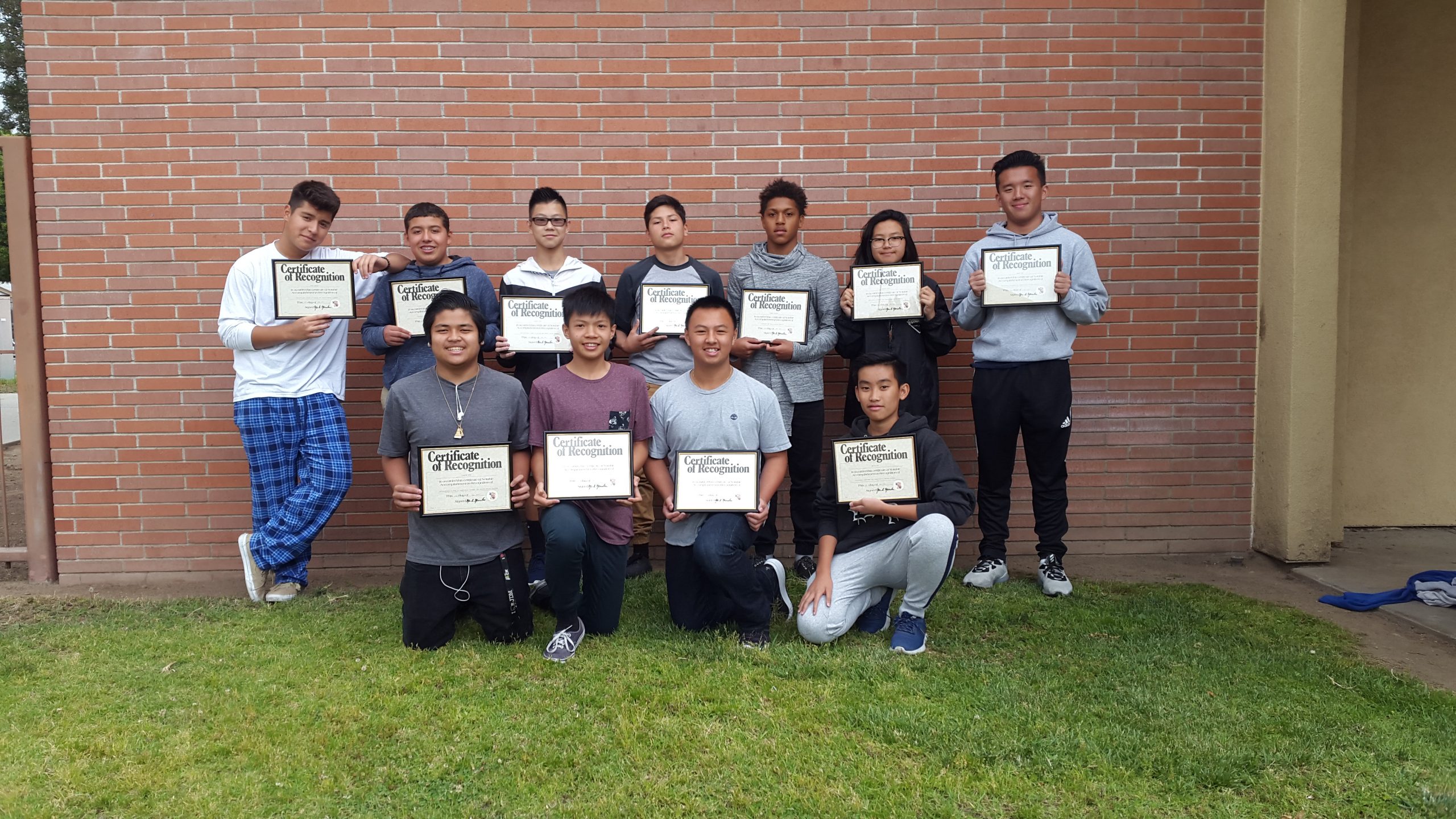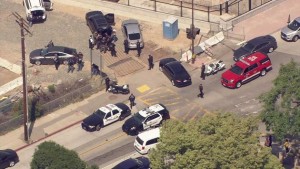
Left to right, top to bottom: Keven Araujo, Jason Predciado, Darwin Sayas, Michael Munoz, Joseph Dolloway, Leilani Trinh, Dillon Mak, Sokhsan Penh, Brian Pham, Timothy Tran, Melvin Loc. Photo by Jennifer Cheung
April lockdown: a look across campus

Photo courtesy of ABC7
San Gabriel High School (SGHS) went under an almost three-hour lockdown on April 11 as an escaped convict, identified as 39-year-old Benedict Romero, was spotted near campus and caused an uproar among the community.
The sighting of an “armed and dangerous escapee” caused police forces to place SGHS, Martha Baldwin Elementary School, Granada Elementary School, and Emmaus Lutheran on lockdown, reported KTLA5. San Gabriel city officials initially tweeted that SGHS was not directly related to the search and warned people to avoid the area. Soon after, it was learned that Romero actually entered SGHS’s campus. The lockdown began at 10:48 a.m. and lasted until 1:28 p.m.
Police tried to apprehend Romero outside of campus on Mission Road and Almansor Street. He fled and was seen near the train tracks, hopping the fence between Mission Road and the softball field, according to Sgt. Steven Carr of the Alhambra Police Department. Romero hid in the bushes near the softball field until a police dog bit him. He was arrested, and the lockdown ended shortly after.
Eyewitness reports, however, said that Romero ran down SGHS’s service road north of campus and through the Teacher Training and Certification Center bungalows, and then likely jumped the fence to the softball field.
E-Building Restroom
Students handled the situation differently depending on where they were located on campus. Sophomores Julia Banuelos, Cindy Alvarez, and Ana Garcia were not in a classroom during the incident.
“We were in the [E-building] restroom and we did not know what to do, so we closed the door,” Banuelos said. “We were in a corner, not in a stall, and sat in front of the door.”
The students were “scared at the moment” and unaware of the circumstances. The group was alone in the restroom for approximately half an hour to an hour until sophomore Allison Moreno notified a school official with her phone. Campus supervisor Pete Gomez came to the site and placed them in a classroom in the E-building that had students and was supervised by a teacher.
Banuelos felt that the situation could have been handled differently. “If we knew what was going on, we could have been able to tell someone quicker,” Banuelos said.
College and Career Center
The Matador staff reporter sophomore Kayla Tang was in the College and Career Center (CCC) during the lockdown.
“At first, I admit that the other 16 peers I was with, along with myself, did not take the lockdown seriously because we thought it was only a drill,” Tang said. “However, once the campus supervisor [Gomez] came in, and we heard his walkie talkie, we found out it was not.”
Students were split into groups—girls hid behind the counter, and boys under the computer desk. Gomez separated the students because if Romero saw all 17 students clumped together, they would be “sitting ducks,” vulnerable to being attacked at once. In addition, he gave students instructions on what to do if they heard a door open: lay on the ground and wait until he gives them a signal to run out the exit.
“The ladies at the [CCC] took good initiative and made sure we understood it was important to remain silent as possible,” Tang said. “All in all, I applaud the way the lockdown was handled—at least in the [CCC].”
Band Room
Romero was closest to the north side of campus, where the P-building, SA-building, and band room are located. Band teacher Tamara Cognetta believed that the lockdown could have been carried out differently.
“I felt we just didn’t get enough of the information—it was coming rather slowly from the office,” Cognetta said. “We were under the impression that the suspect was not on campus; that he was in the area, so it was awhile before we really knew he was on the campus, making everyone a little more nervous.”
Some teachers, such as Cognetta, got more information from students on their phones instead of the office. She suggested that the best thing would be an update every 15 minutes, even if the update said “‘Same situation, nothing new to report.’” She also said that being on the football field during a lockdown was a whole other situation that needs to be discussed since there is “very little protection” and bells cannot be heard from the location.
“I just hope this never ever happens again, but I was with a great group of kids that handled it well and there was no panicking or getting sick,” Cognetta said.
SA-Building: Students awarded for bravery
English teacher Sabrina Morales and her freshman class were in SA7 near the band room in their class watching a movie, when they heard police sirens for ten minutes. Morales went outside to check, and freshman Sokhsan Penh received a text from his sister, saying that a lockdown would happen. Penh went outside to tell Morales. Both returned to class quickly.
Suspicious of the noises, Morales and her students locked and barricaded both doors. The commotion was finalized with the lockdown bell.
“[The man] did try to open the [front] door twice,” freshman Keven Araujo believed. “We had desks near the sides of the door and I had my head under them. Next thing you know, I heard shaking [from the door].”
Morales was proud of how her students conducted themselves.
“Students took immediate action to secure the room and safeguard the perimeters,” she said. “They were checking local police stations and television news sources to get updated information. Helicopters were providing aerial views and students were online viewing the footage so we could reassess our situation in the classroom.”
Morales awarded her students with certificates of recognition for their “outstanding acts of bravery, courage, and alertness.” Two different certificates were handed out—Post I and Post II—each post representing which door each student was guarding. Those that received awards for Post I (front door) were: Keven Araujo, Darwin Sayas, Leilani Trinh, Dillon Mak, Brian Pham, Timothy Tran, Melvin Loc, and Sokhsan Penh; Post II (hallway door): Jason Preciado, Michael Munoz, and Joseph Dolloway.
Similar to many others, Morales believes that there were flaws in the methods used to communicate with staff during the lockdown.
“[Teachers] need constant communication as it comes in, so we can make better informed decisions to ensure the safety of our students and community at large,” Morales said. “It is vital that staff members are informed about the situation at hand. We should not have to rely on outside sources for vital information. We need to reexamine the Comprehensive School Site Safety Plan.”
Physical Education Class
Although Morales and her class did not have direct contact with Romero, girls basketball Head Coach and physical education teacher Jordan Franey and her class did near the north parking lot.
“We were about 10 minutes into our walk and a couple kids saw him,” Franey said. “We saw the cops trying to go after him and then I had a couple officers tell me to go into lockdown, so I was probably first one to know that it was a lockdown situation.”
She and her class took shelter along with the students in the woodshop classroom. She told others nearby that there was someone on campus.
“A couple of [kids] were apprehensive, especially when the San Bernardino elementary school shooting happened the day before, so everyone was a little bit more on edge,” Franey said. “My kids and the woodshop kids did a great job. Everyone just seemed calm and they had questions, but I think everyone handled it really well.”
After the lockdown
Principal Debbie Stone held an opportunity for staff to debrief and give input the next day after lockdown.
“When a situation like this happens, it is unfortunate, but an opportunity to reflect and to make adjustments and to be as best prepared as we can be,” Stone said. “If teachers see or hear something, they need to make the best decision to insure the safety of their students.”
Stone admitted that there are things that can be improved the next time a lockdown occurs.
“We need to give our substitute teachers more information about emergency protocol,” she said.
Prior to the lockdown, staff members were invited to attend an intense simulation of a lockdown at Alhambra High School on Sep. 10 and 17. This was a three-hour simulation and practice rehearsal, followed by a review of the procedures. It was not mandatory to attend, but teachers who were present appreciated the experience, Stone said.
Additionally, all staff members attended a critical incident training session during their conference period in November.
“I am very proud of how our staff and students handled the situation,” Stone said. “The outcome is exactly how we want; everyone is safe, and we proceeded with the rest of the day.”
SUPER GREAT !!! Can find the words to congratulate you on your student that wrote that article. Fanatic, awesome, fabuloso (Spanish) I just feel so proud that you are the teacher you are.